Cystic Fibrosis: Pathophysiology, Manifestations, Report
VerifiedAdded on 2022/11/14
|7
|1269
|450
Report
AI Summary
This report provides a detailed overview of the pathophysiology of cystic fibrosis, a genetic disorder characterized by thick mucus production that affects multiple organs, particularly the lungs and pancreas. The report begins by discussing the etiology and risk factors associated with the disease, including the defective CFTR gene on chromosome 7 and its hereditary nature. It then delves into the pathophysiological processes, highlighting how mutations in the CFTR gene disrupt chloride ion transport, leading to thick secretions that obstruct airways and pancreatic ducts. The clinical manifestations and complications are explored, including persistent cough, wheezing, salty skin, and weight gain failure, as well as complications like respiratory failure and diabetes. Finally, the report outlines the diagnostic methods, such as sweat tests, blood tests, and imaging techniques used to identify and assess the severity of cystic fibrosis. The report underscores the importance of early diagnosis and treatment to manage the disease and mitigate its complications.
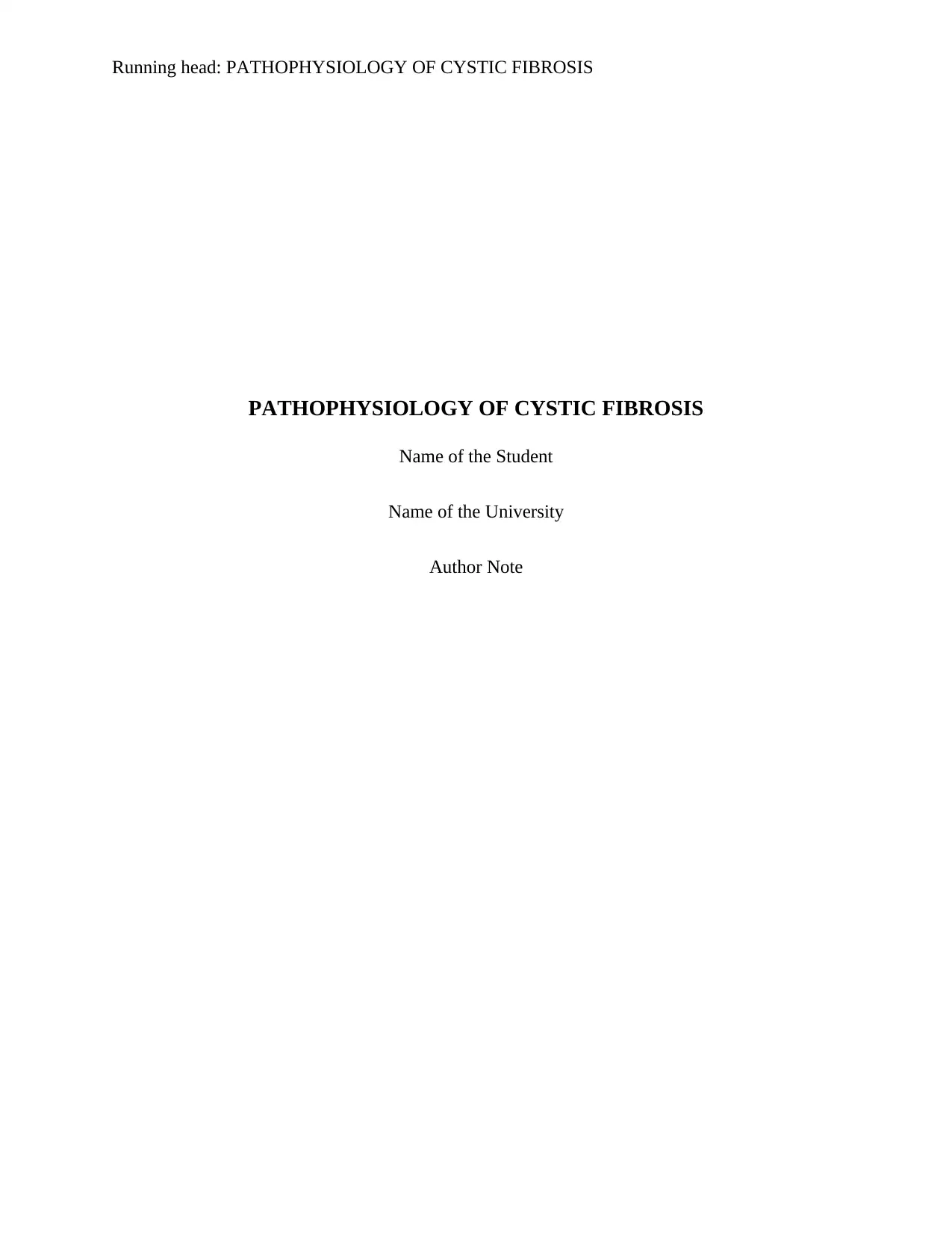
Running head: PATHOPHYSIOLOGY OF CYSTIC FIBROSIS
PATHOPHYSIOLOGY OF CYSTIC FIBROSIS
Name of the Student
Name of the University
Author Note
PATHOPHYSIOLOGY OF CYSTIC FIBROSIS
Name of the Student
Name of the University
Author Note
Paraphrase This Document
Need a fresh take? Get an instant paraphrase of this document with our AI Paraphraser
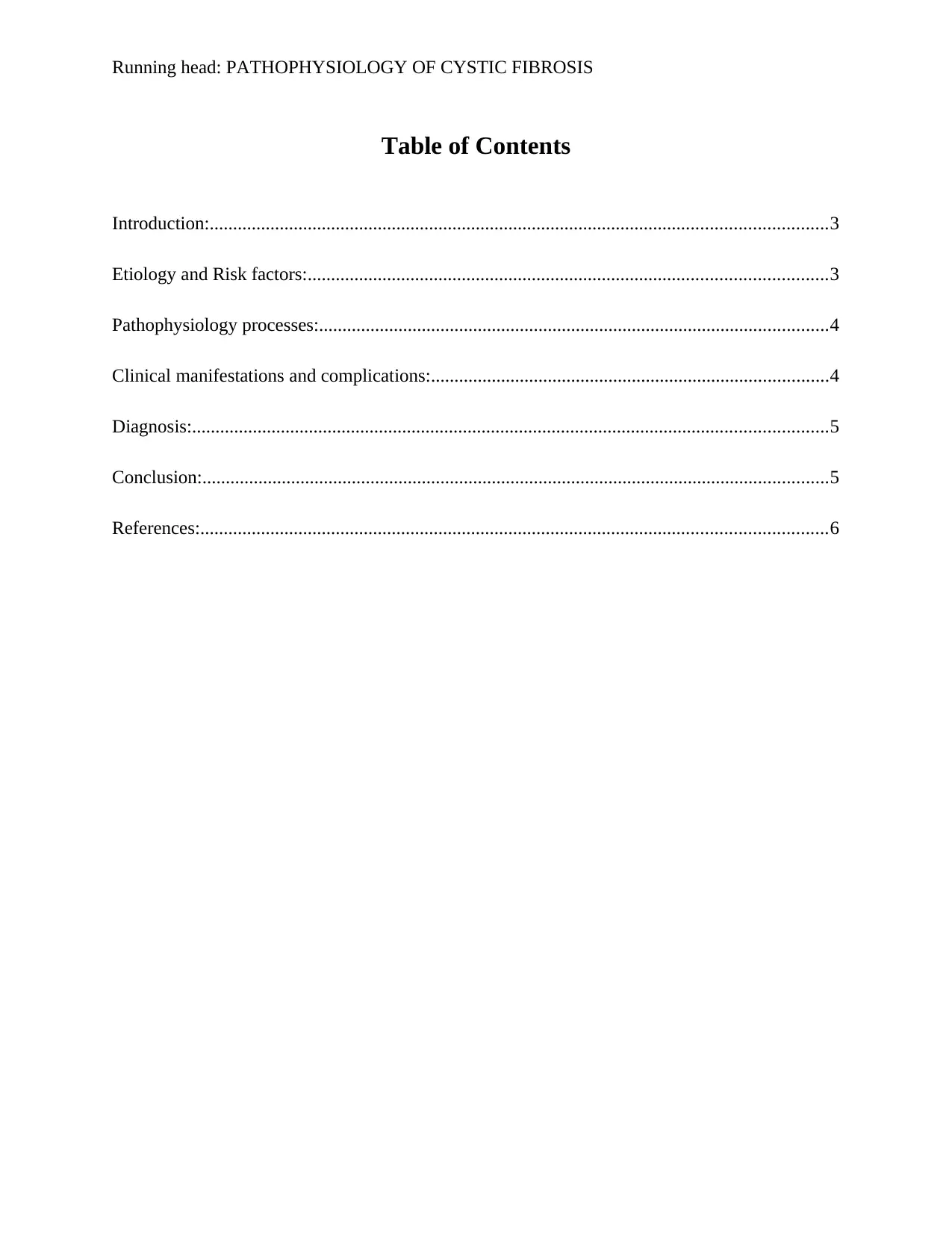
Running head: PATHOPHYSIOLOGY OF CYSTIC FIBROSIS
Table of Contents
Introduction:....................................................................................................................................3
Etiology and Risk factors:...............................................................................................................3
Pathophysiology processes:.............................................................................................................4
Clinical manifestations and complications:.....................................................................................4
Diagnosis:........................................................................................................................................5
Conclusion:......................................................................................................................................5
References:......................................................................................................................................6
Table of Contents
Introduction:....................................................................................................................................3
Etiology and Risk factors:...............................................................................................................3
Pathophysiology processes:.............................................................................................................4
Clinical manifestations and complications:.....................................................................................4
Diagnosis:........................................................................................................................................5
Conclusion:......................................................................................................................................5
References:......................................................................................................................................6
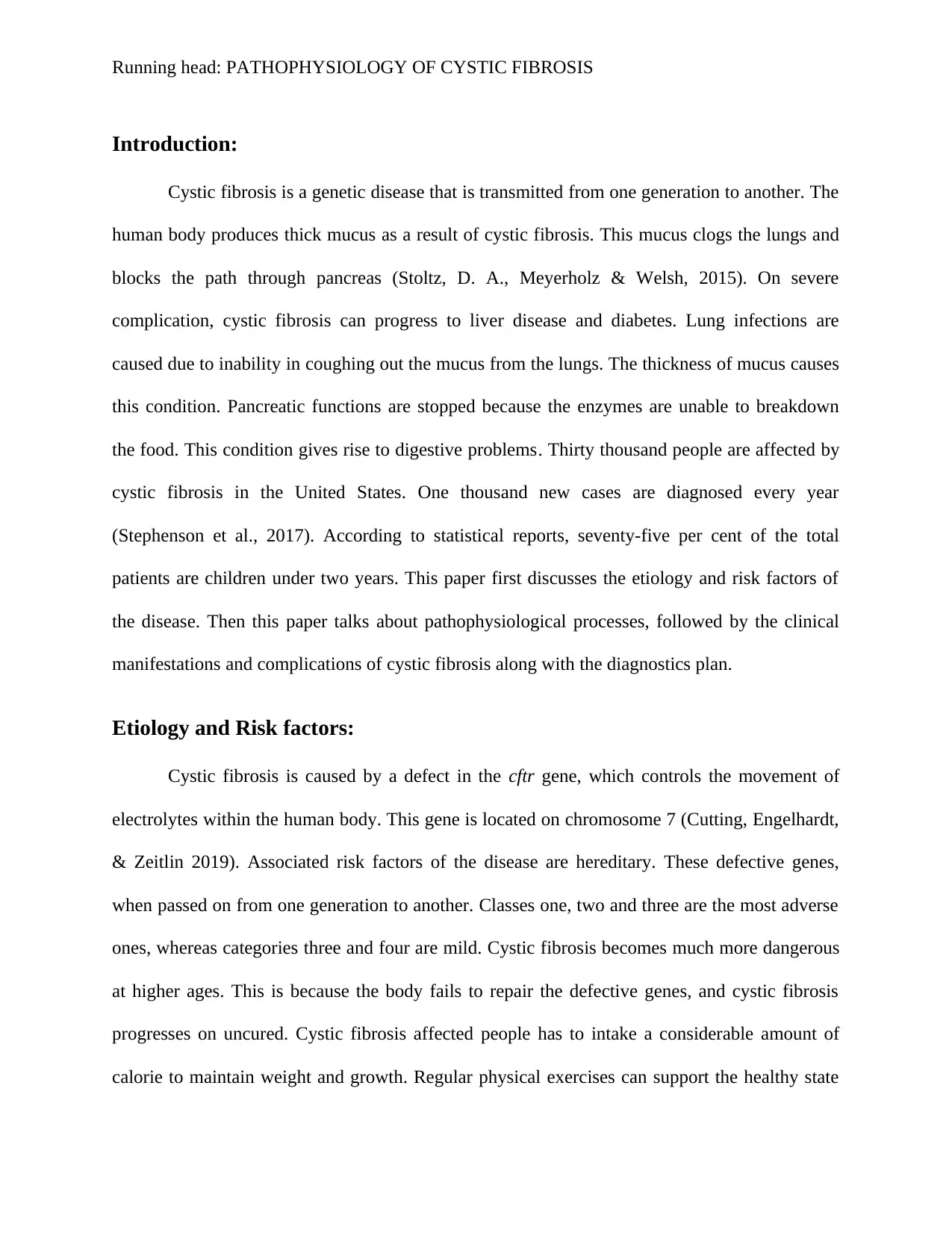
Running head: PATHOPHYSIOLOGY OF CYSTIC FIBROSIS
Introduction:
Cystic fibrosis is a genetic disease that is transmitted from one generation to another. The
human body produces thick mucus as a result of cystic fibrosis. This mucus clogs the lungs and
blocks the path through pancreas (Stoltz, D. A., Meyerholz & Welsh, 2015). On severe
complication, cystic fibrosis can progress to liver disease and diabetes. Lung infections are
caused due to inability in coughing out the mucus from the lungs. The thickness of mucus causes
this condition. Pancreatic functions are stopped because the enzymes are unable to breakdown
the food. This condition gives rise to digestive problems. Thirty thousand people are affected by
cystic fibrosis in the United States. One thousand new cases are diagnosed every year
(Stephenson et al., 2017). According to statistical reports, seventy-five per cent of the total
patients are children under two years. This paper first discusses the etiology and risk factors of
the disease. Then this paper talks about pathophysiological processes, followed by the clinical
manifestations and complications of cystic fibrosis along with the diagnostics plan.
Etiology and Risk factors:
Cystic fibrosis is caused by a defect in the cftr gene, which controls the movement of
electrolytes within the human body. This gene is located on chromosome 7 (Cutting, Engelhardt,
& Zeitlin 2019). Associated risk factors of the disease are hereditary. These defective genes,
when passed on from one generation to another. Classes one, two and three are the most adverse
ones, whereas categories three and four are mild. Cystic fibrosis becomes much more dangerous
at higher ages. This is because the body fails to repair the defective genes, and cystic fibrosis
progresses on uncured. Cystic fibrosis affected people has to intake a considerable amount of
calorie to maintain weight and growth. Regular physical exercises can support the healthy state
Introduction:
Cystic fibrosis is a genetic disease that is transmitted from one generation to another. The
human body produces thick mucus as a result of cystic fibrosis. This mucus clogs the lungs and
blocks the path through pancreas (Stoltz, D. A., Meyerholz & Welsh, 2015). On severe
complication, cystic fibrosis can progress to liver disease and diabetes. Lung infections are
caused due to inability in coughing out the mucus from the lungs. The thickness of mucus causes
this condition. Pancreatic functions are stopped because the enzymes are unable to breakdown
the food. This condition gives rise to digestive problems. Thirty thousand people are affected by
cystic fibrosis in the United States. One thousand new cases are diagnosed every year
(Stephenson et al., 2017). According to statistical reports, seventy-five per cent of the total
patients are children under two years. This paper first discusses the etiology and risk factors of
the disease. Then this paper talks about pathophysiological processes, followed by the clinical
manifestations and complications of cystic fibrosis along with the diagnostics plan.
Etiology and Risk factors:
Cystic fibrosis is caused by a defect in the cftr gene, which controls the movement of
electrolytes within the human body. This gene is located on chromosome 7 (Cutting, Engelhardt,
& Zeitlin 2019). Associated risk factors of the disease are hereditary. These defective genes,
when passed on from one generation to another. Classes one, two and three are the most adverse
ones, whereas categories three and four are mild. Cystic fibrosis becomes much more dangerous
at higher ages. This is because the body fails to repair the defective genes, and cystic fibrosis
progresses on uncured. Cystic fibrosis affected people has to intake a considerable amount of
calorie to maintain weight and growth. Regular physical exercises can support the healthy state
⊘ This is a preview!⊘
Do you want full access?
Subscribe today to unlock all pages.

Trusted by 1+ million students worldwide
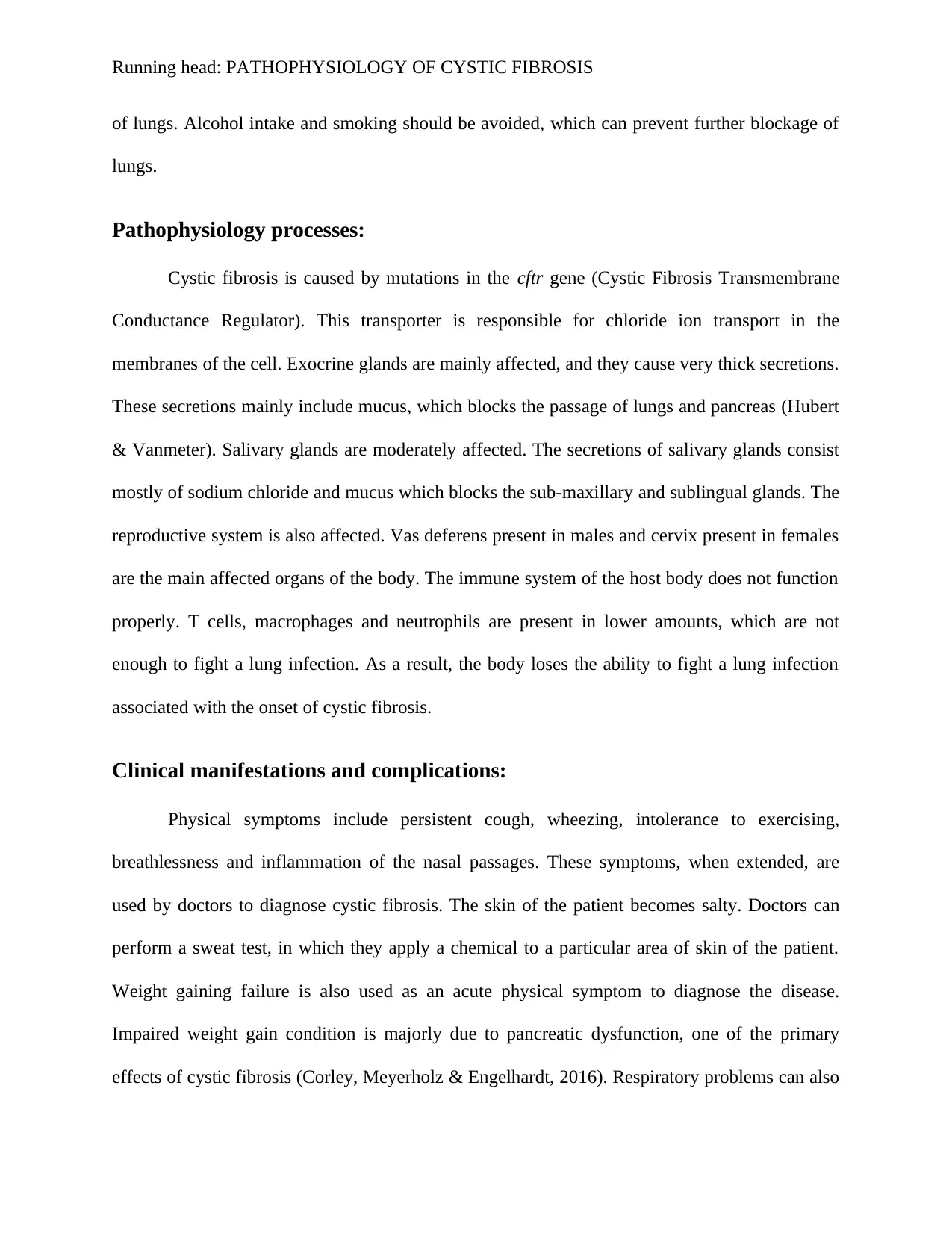
Running head: PATHOPHYSIOLOGY OF CYSTIC FIBROSIS
of lungs. Alcohol intake and smoking should be avoided, which can prevent further blockage of
lungs.
Pathophysiology processes:
Cystic fibrosis is caused by mutations in the cftr gene (Cystic Fibrosis Transmembrane
Conductance Regulator). This transporter is responsible for chloride ion transport in the
membranes of the cell. Exocrine glands are mainly affected, and they cause very thick secretions.
These secretions mainly include mucus, which blocks the passage of lungs and pancreas (Hubert
& Vanmeter). Salivary glands are moderately affected. The secretions of salivary glands consist
mostly of sodium chloride and mucus which blocks the sub-maxillary and sublingual glands. The
reproductive system is also affected. Vas deferens present in males and cervix present in females
are the main affected organs of the body. The immune system of the host body does not function
properly. T cells, macrophages and neutrophils are present in lower amounts, which are not
enough to fight a lung infection. As a result, the body loses the ability to fight a lung infection
associated with the onset of cystic fibrosis.
Clinical manifestations and complications:
Physical symptoms include persistent cough, wheezing, intolerance to exercising,
breathlessness and inflammation of the nasal passages. These symptoms, when extended, are
used by doctors to diagnose cystic fibrosis. The skin of the patient becomes salty. Doctors can
perform a sweat test, in which they apply a chemical to a particular area of skin of the patient.
Weight gaining failure is also used as an acute physical symptom to diagnose the disease.
Impaired weight gain condition is majorly due to pancreatic dysfunction, one of the primary
effects of cystic fibrosis (Corley, Meyerholz & Engelhardt, 2016). Respiratory problems can also
of lungs. Alcohol intake and smoking should be avoided, which can prevent further blockage of
lungs.
Pathophysiology processes:
Cystic fibrosis is caused by mutations in the cftr gene (Cystic Fibrosis Transmembrane
Conductance Regulator). This transporter is responsible for chloride ion transport in the
membranes of the cell. Exocrine glands are mainly affected, and they cause very thick secretions.
These secretions mainly include mucus, which blocks the passage of lungs and pancreas (Hubert
& Vanmeter). Salivary glands are moderately affected. The secretions of salivary glands consist
mostly of sodium chloride and mucus which blocks the sub-maxillary and sublingual glands. The
reproductive system is also affected. Vas deferens present in males and cervix present in females
are the main affected organs of the body. The immune system of the host body does not function
properly. T cells, macrophages and neutrophils are present in lower amounts, which are not
enough to fight a lung infection. As a result, the body loses the ability to fight a lung infection
associated with the onset of cystic fibrosis.
Clinical manifestations and complications:
Physical symptoms include persistent cough, wheezing, intolerance to exercising,
breathlessness and inflammation of the nasal passages. These symptoms, when extended, are
used by doctors to diagnose cystic fibrosis. The skin of the patient becomes salty. Doctors can
perform a sweat test, in which they apply a chemical to a particular area of skin of the patient.
Weight gaining failure is also used as an acute physical symptom to diagnose the disease.
Impaired weight gain condition is majorly due to pancreatic dysfunction, one of the primary
effects of cystic fibrosis (Corley, Meyerholz & Engelhardt, 2016). Respiratory problems can also
Paraphrase This Document
Need a fresh take? Get an instant paraphrase of this document with our AI Paraphraser
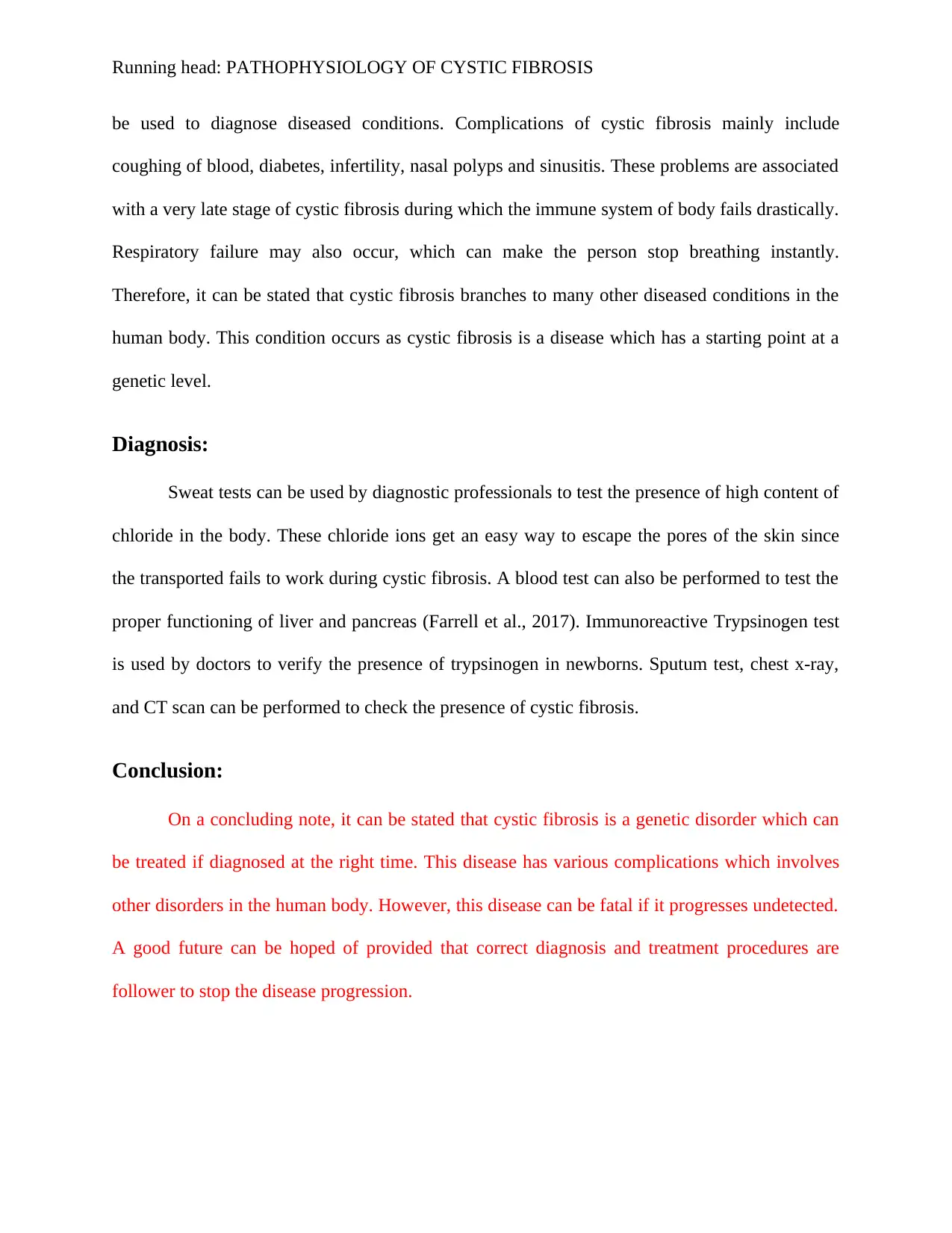
Running head: PATHOPHYSIOLOGY OF CYSTIC FIBROSIS
be used to diagnose diseased conditions. Complications of cystic fibrosis mainly include
coughing of blood, diabetes, infertility, nasal polyps and sinusitis. These problems are associated
with a very late stage of cystic fibrosis during which the immune system of body fails drastically.
Respiratory failure may also occur, which can make the person stop breathing instantly.
Therefore, it can be stated that cystic fibrosis branches to many other diseased conditions in the
human body. This condition occurs as cystic fibrosis is a disease which has a starting point at a
genetic level.
Diagnosis:
Sweat tests can be used by diagnostic professionals to test the presence of high content of
chloride in the body. These chloride ions get an easy way to escape the pores of the skin since
the transported fails to work during cystic fibrosis. A blood test can also be performed to test the
proper functioning of liver and pancreas (Farrell et al., 2017). Immunoreactive Trypsinogen test
is used by doctors to verify the presence of trypsinogen in newborns. Sputum test, chest x-ray,
and CT scan can be performed to check the presence of cystic fibrosis.
Conclusion:
On a concluding note, it can be stated that cystic fibrosis is a genetic disorder which can
be treated if diagnosed at the right time. This disease has various complications which involves
other disorders in the human body. However, this disease can be fatal if it progresses undetected.
A good future can be hoped of provided that correct diagnosis and treatment procedures are
follower to stop the disease progression.
be used to diagnose diseased conditions. Complications of cystic fibrosis mainly include
coughing of blood, diabetes, infertility, nasal polyps and sinusitis. These problems are associated
with a very late stage of cystic fibrosis during which the immune system of body fails drastically.
Respiratory failure may also occur, which can make the person stop breathing instantly.
Therefore, it can be stated that cystic fibrosis branches to many other diseased conditions in the
human body. This condition occurs as cystic fibrosis is a disease which has a starting point at a
genetic level.
Diagnosis:
Sweat tests can be used by diagnostic professionals to test the presence of high content of
chloride in the body. These chloride ions get an easy way to escape the pores of the skin since
the transported fails to work during cystic fibrosis. A blood test can also be performed to test the
proper functioning of liver and pancreas (Farrell et al., 2017). Immunoreactive Trypsinogen test
is used by doctors to verify the presence of trypsinogen in newborns. Sputum test, chest x-ray,
and CT scan can be performed to check the presence of cystic fibrosis.
Conclusion:
On a concluding note, it can be stated that cystic fibrosis is a genetic disorder which can
be treated if diagnosed at the right time. This disease has various complications which involves
other disorders in the human body. However, this disease can be fatal if it progresses undetected.
A good future can be hoped of provided that correct diagnosis and treatment procedures are
follower to stop the disease progression.
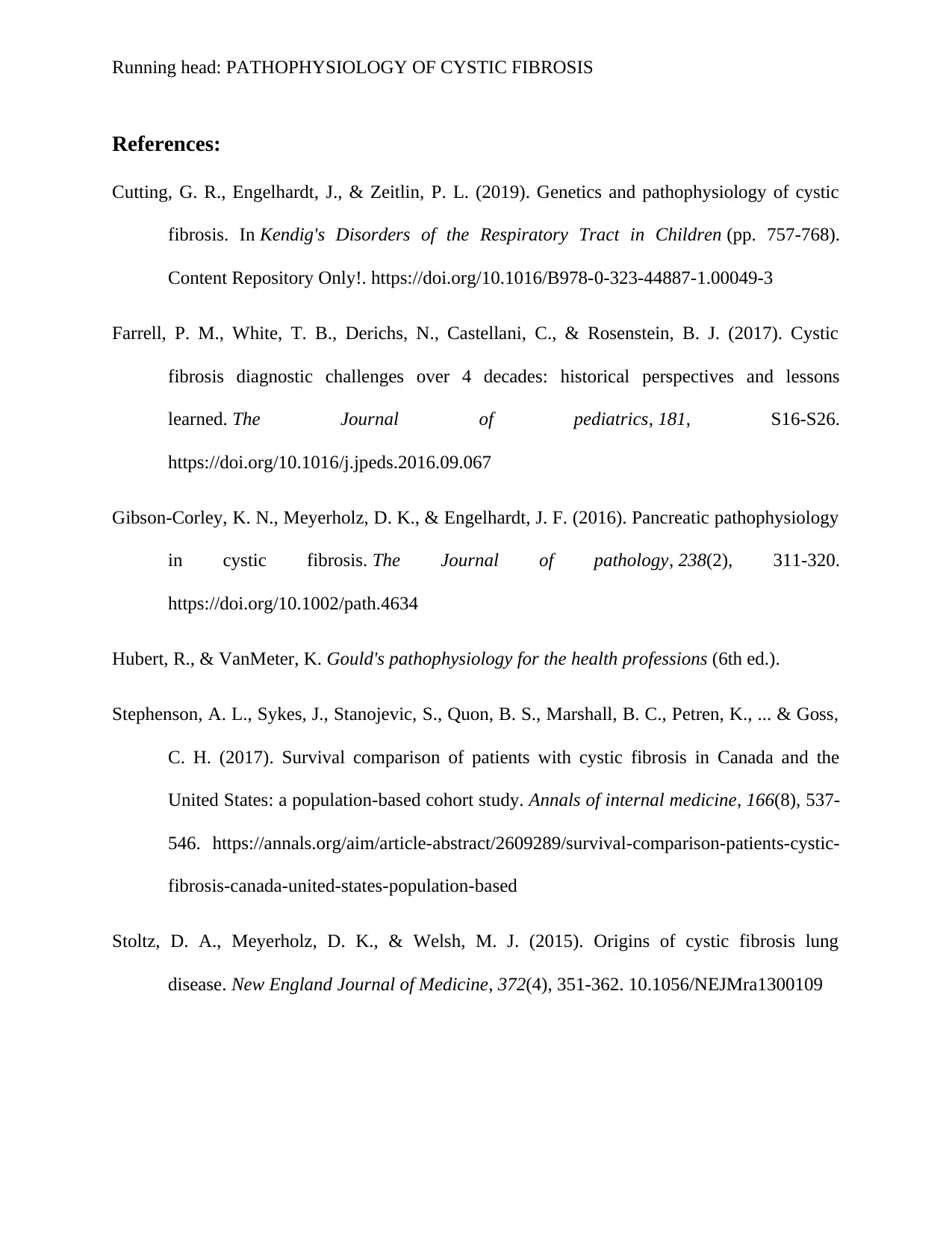
Running head: PATHOPHYSIOLOGY OF CYSTIC FIBROSIS
References:
Cutting, G. R., Engelhardt, J., & Zeitlin, P. L. (2019). Genetics and pathophysiology of cystic
fibrosis. In Kendig's Disorders of the Respiratory Tract in Children (pp. 757-768).
Content Repository Only!. https://doi.org/10.1016/B978-0-323-44887-1.00049-3
Farrell, P. M., White, T. B., Derichs, N., Castellani, C., & Rosenstein, B. J. (2017). Cystic
fibrosis diagnostic challenges over 4 decades: historical perspectives and lessons
learned. The Journal of pediatrics, 181, S16-S26.
https://doi.org/10.1016/j.jpeds.2016.09.067
Gibson‐Corley, K. N., Meyerholz, D. K., & Engelhardt, J. F. (2016). Pancreatic pathophysiology
in cystic fibrosis. The Journal of pathology, 238(2), 311-320.
https://doi.org/10.1002/path.4634
Hubert, R., & VanMeter, K. Gould's pathophysiology for the health professions (6th ed.).
Stephenson, A. L., Sykes, J., Stanojevic, S., Quon, B. S., Marshall, B. C., Petren, K., ... & Goss,
C. H. (2017). Survival comparison of patients with cystic fibrosis in Canada and the
United States: a population-based cohort study. Annals of internal medicine, 166(8), 537-
546. https://annals.org/aim/article-abstract/2609289/survival-comparison-patients-cystic-
fibrosis-canada-united-states-population-based
Stoltz, D. A., Meyerholz, D. K., & Welsh, M. J. (2015). Origins of cystic fibrosis lung
disease. New England Journal of Medicine, 372(4), 351-362. 10.1056/NEJMra1300109
References:
Cutting, G. R., Engelhardt, J., & Zeitlin, P. L. (2019). Genetics and pathophysiology of cystic
fibrosis. In Kendig's Disorders of the Respiratory Tract in Children (pp. 757-768).
Content Repository Only!. https://doi.org/10.1016/B978-0-323-44887-1.00049-3
Farrell, P. M., White, T. B., Derichs, N., Castellani, C., & Rosenstein, B. J. (2017). Cystic
fibrosis diagnostic challenges over 4 decades: historical perspectives and lessons
learned. The Journal of pediatrics, 181, S16-S26.
https://doi.org/10.1016/j.jpeds.2016.09.067
Gibson‐Corley, K. N., Meyerholz, D. K., & Engelhardt, J. F. (2016). Pancreatic pathophysiology
in cystic fibrosis. The Journal of pathology, 238(2), 311-320.
https://doi.org/10.1002/path.4634
Hubert, R., & VanMeter, K. Gould's pathophysiology for the health professions (6th ed.).
Stephenson, A. L., Sykes, J., Stanojevic, S., Quon, B. S., Marshall, B. C., Petren, K., ... & Goss,
C. H. (2017). Survival comparison of patients with cystic fibrosis in Canada and the
United States: a population-based cohort study. Annals of internal medicine, 166(8), 537-
546. https://annals.org/aim/article-abstract/2609289/survival-comparison-patients-cystic-
fibrosis-canada-united-states-population-based
Stoltz, D. A., Meyerholz, D. K., & Welsh, M. J. (2015). Origins of cystic fibrosis lung
disease. New England Journal of Medicine, 372(4), 351-362. 10.1056/NEJMra1300109
⊘ This is a preview!⊘
Do you want full access?
Subscribe today to unlock all pages.

Trusted by 1+ million students worldwide

Running head: PATHOPHYSIOLOGY OF CYSTIC FIBROSIS
1 out of 7
Related Documents
Your All-in-One AI-Powered Toolkit for Academic Success.
+13062052269
info@desklib.com
Available 24*7 on WhatsApp / Email
![[object Object]](/_next/static/media/star-bottom.7253800d.svg)
Unlock your academic potential
Copyright © 2020–2025 A2Z Services. All Rights Reserved. Developed and managed by ZUCOL.





